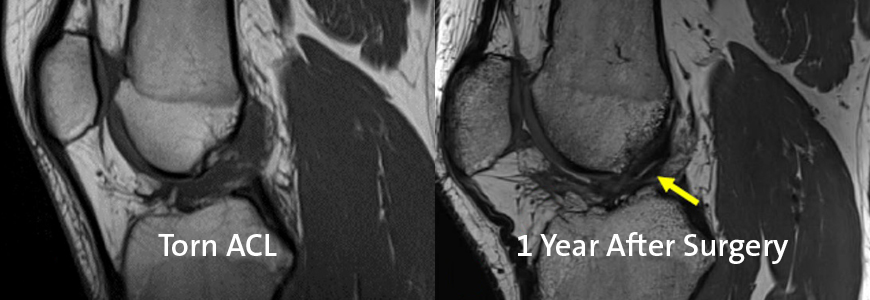A team of Duke orthopaedic surgeons offer a novel, enhanced repair for ACL tear that uses an implant designed to preserve native fibers in the ligament to encourage faster healing. Pioneering the implementation of the bridge-enhanced ACL repair (BEAR) procedure with multiple surgeons, Duke is a national leader as one of the top four institutions in total BEAR procedures completed.
The BEAR procedure promotes internal ACL healing, says Brian C. Lau, MD, the first Duke surgeon to perform the procedure. Lau and colleagues are participating in a national study analyzing long-term outcomes at Duke and nationally. The FDA-approved BEAR implant was developed by Miach Orthopaedics, Inc., Westborough, Massachusetts.
Lau is the lead surgeon with two other Duke surgeons participating in a grant with the manufacturer to study outcomes for patients who receive the BEAR implant. In addition to Lau, the other surgeons are Dean C. Taylor, MD, and Jocelyn R. Wittstein, MD.
A sponge-like implant, which is injected with the patient’s blood, is the key to the BEAR procedure. After stitching is completed on the torn ends of the ACL, the insert is placed in the gap between the torn ligaments. Surgeons do additional stitching to secure the device. In approximately eight weeks, the body absorbs the implant, replacing it with new tissue.
“The biggest factor in the use of BEAR is that every surgical team is still learning about the procedure and the outcomes,” Lau says. “It is certainly better for patients to choose a team that has experience in the procedure as well as a well-established recovery and rehabilitation program.”
Duke’s distinctive approach
Patients must meet specific criteria to quality for the procedure, Lau says. The procedure must take place within 50 days of the injury and a sufficient amount of ACL tissue is required. Duke surgeons have incorporated modifications to benefit their patients; they began performing the procedure early in 2022.
“What makes Duke’s process different is that we have modified the procedure to make it less invasive,” Lau says. “We also offer an established, proven rehabilitation program that helps ensure long-term health for these patients."
Patient benefits
The procedure is less invasive that a traditional ACL procedure, which requires drilling through a bone to complete the repair, Lau says. In addition, patients experience less knee morbidity because no tissue is taken from the patient’s knee. The use of the native ACL promotes the quicker healing process, he adds.
“We hope that this process preserves tissue and other sensory fibers that will help with rehabilitation and give the patient an option to return to sports or rigorous physical activities as soon as possible,” Lau says.
Duke surgeons follow a standard rehabilitation protocol for all ACL reconstruction procedures, but Lau predicts that data gleaned from the BEAR trial will eventually shorten the rehabilitation time frame.
For patients who need ACL surgery but do not meet the criteria for a BEAR implant, Duke orthopaedic surgeons offer treatment options customized for young adult athletes. Soccer players with ACL injuries benefit from the experience at Duke, one of only three FIFA Medical Centers of Excellence in the United States. Only 49 centers have earned this distinction internationally.

